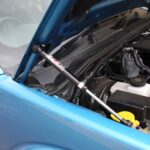Aerospace coatings can be used on any metal or other material. This includes aerospace equipment and structures. They can also be applied to non-aero surfaces, such as satellites, spacecraft, and automated control systems for ground vehicles. Below are ways in how aerospace coatings protect from corrosion.
Promotes Corrosion Prevention
Coatings’ first and most crucial role is protecting the underlying material from corrosion in the equipment or structure’s environment. Even though many aerospace equipment and structures variations could cause corrosion, there is one constant. The equipment or structure will be exposed to a variable and fluctuating set of environmental conditions. For example, the ambient temperature will vary from day to tonight.
Air pressure may change with altitude and humidity and with time since assembly or supply. Without the protection provided by coatings, any corrosion would likely occur. Aerospace coatings are typically combined with other treatment methods to achieve several properties and performance attributes. They may also provide a secondary layer of protection against corrosion known as cathodic protection. They allow another anti-corrosion method to reduce the electrolytic corrosion potential when this happens.
Enhances Corrosion Resistance
It is also essential that coatings have a high oxidation resistance. This means they must be resistant to corrosion at room temperature and pressure, in addition to a wide range of environmental conditions. This includes humidity and exposure to water or other liquids.
For aerospace coatings, such as those containing PVD, the layer can be exposed for long periods between maintenance cycles or during operation when the ambient conditions may not be as harsh. In this instance, other forms of materials may not be as effective in preventing corrosion.
Prevents Corrosion Fatigue
Critical components or systems may experience several mechanical stresses for aircraft and aerospace components. Some of these stresses may be caused by the materials used in the manufacturing process and preparation of the element. Small cracks occur and grow in length with time causing overall deformation or damage to the part or system. This leads to fatigue failures due to the accumulation of small cracks with time.
Finally, one of these cracks will grow to such a size that it ruptures and causes failure of the component or system. Inhibitors are critical in helping to prevent corrosion fatigue failures. This includes even when wearing components that have been used in high-stress environments. Inhibitors also help prevent corrosion fatigue when metal parts wear coatings under extreme conditions or heavy loads.
Promotes Corrosion Inhibition
There are many types of corrosion. However, the two primary forms of corrosion in the aerospace industry are galvanic corrosion and electrolytic corrosion. With time, this will lead to weakening or deterioration of the coating. This presents a significant challenge. The component or system may need to be replaced to maintain reliability and safety through these harsh environments. The result can be a catastrophic failure of the element or damage to other affected parts.
If a coating is seriously damaged and cannot be repaired, it must be replaced with an alternative anti-corrosion method such as passivation. Inhibitors are essential to limiting the corrosive effects of galvanic corrosion. They work by lowering the atmospheric corrosion cell potential. This prevents galvanic corrosion from occurring in areas of concern.
Enhances Corrosion Tolerance
All of the considerations of the aerospace film above are important. However, perhaps the most important one is that it prevents corrosion from occurring at all. This is known as corrosion tolerance. It can be defined as the ability of a coating to withstand a given level of corrosion before it becomes ineffective or unable to achieve its original purpose.
For example, if an aircraft is flying over water, it has high flexibility. This is to ensure no adverse effects from saltwater. This means it must be anti-corrosive when used in these harsh environmental conditions. Some coatings have a very high corrosion tolerance. However, others may have a lower corrosion tolerance. There is no one size fits all answer.
It is crucial to ensure that coatings are compatible with their applications. For this reason, it is essential to select the best layer for each application. Your selection should be based on the material and performance requirements. It is also crucial to consider the application, environment, and maintenance requirements. If the latter is not considered carefully when selecting a coating, it may not perform effectively under certain conditions.







